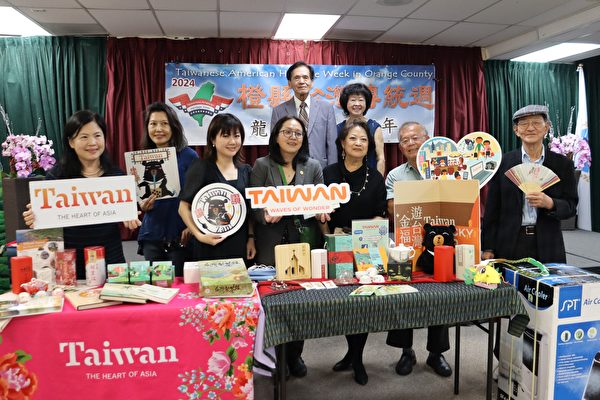On May 26th, at the Orange County Center, the opening ceremony of the “Dragon Leaps in Tainan 400th Anniversary Photography Exhibition and Taiwan Tourism Lecture” was held. The president of the American Six-Kui Clan Association and photographer, Hong Jiadong, as well as the head of the Tourism Department of the Los Angeles Office, Lin Yizheng, gave insightful explanations. The Orange County Taiwan Traditional Week Committee also prepared medical lectures, art performances, music appreciation, photo exhibitions, and a baseball league event.
Director Xiao Beiru of the Orange County Center expressed her hope that everyone would see Taiwan as “a diverse, friendly, and attractive place”.
After the epidemic, people are making travel arrangements, and Taiwan is the top choice for tourism. “As soon as you arrive at Taoyuan Airport, you can find someone who speaks English to help you plan your itinerary. Road signs are bilingual in Chinese and English, and the cities have free Wi-Fi,” Xiao Beiru said. Tainan is one of Taiwan’s oldest cities with rich cultural heritage and natural landscapes; the photography exhibition aims to “introduce more people to Tainan, to step into Tainan, and to experience its unique scenery”.
Hong Jiadong, a mechanical engineer who started photography 7-8 years ago, retired three years ago and had the opportunity to return to Taiwan for photography. Through video link, he said, “This year marks the 400th anniversary of Tainan’s founding. The main lantern of the Dragon Year Lantern Festival is in Tainan, where there are sites like Anping Fort, Confucius Temple, Mazu Temple, and Chimei Museum.” He has visited many historical sites and lantern festivals more than once, aiming to “show Tainan’s ancient sites and modern architecture through photos” and “reexamine history and walk his own path”.
“Photography requires looking at the weather, relying on luck, and being adaptable. When shooting at Chimei Museum, I happened to capture a beam of sunlight shining on the horse statue, making it a very rare opportunity,” said Hong Jiadong. He also mentioned that when it rains, one has to wait. The first day of the Tainan Lantern Festival attracted 400,000 people, it was grand and magnificent; however, amidst the crowd, it was difficult to seize the opportunity for a shot. Thus, he had to go a second time to capture the desired scene.
In 1624, the Dutch established the present-day Anping Fort trading town in Tainan, which was previously inhabited by the Siraya Indigenous Peoples. In 1661, when Zheng Chenggong retreated to Taiwan, he established the island’s highest administrative capital there. In 1684, the Qing Dynasty conquered Taiwan and set up the Taiwan Prefecture there. After the signing of the “Treaty of Shimonoseki” in 1895, Taiwan entered the Japanese colonial period; in 1945, Taiwan was taken over by the Nationalist Government.
At the end of March 2024, the “Big Red Ball” was exhibited in 10 locations in Tainan City. The Red Ball Project was created by American artist Kurt Perschke in 2001. Since visiting Barcelona in 2002, the project has been to over 40 cities globally, including Sydney, Tokyo, Paris, Taipei, Montreal, Chicago, and Los Angeles. The red ball has a diameter of 5 feet (4.572 meters), weighs 122 kilograms, and is displayed at each specific location for a day to inspire different artistic creations and public interaction.
Lin Yizheng introduced that this year’s Tourism Bureau Lantern Festival, coinciding with Tainan’s 400th anniversary and the Year of the Dragon, features a theme of “Dragons Coming to Taiwan”. The festival covers 50 hectares of land with 40 main lantern displays. Concerning geomancy, there are gold dragons, water dragons, as well as themes like Formosa, Pearl of the Sea, Must Succeed, and some incorporation of young people’s new skills. She suggested that tourists should view the lanterns at night and explore the surrounding area during the day.
Each year, the Tourism Bureau’s lantern festivals revolve around different themes, integrating the concepts of “lantern art heritage, cultural innovation, and international celebrations,” spanning the past 35 years since 1990. These festivals not only offer delicious and fun activities but have also been selected as world heritage sites. Lin Yizheng stated, “I hope everyone has the opportunity to witness and experience it firsthand.”
Lin Yizheng also introduced the “Three Mountains” National Scenic Area, which includes Lion’s Head Mountain in Hsinchu and Miaoli Counties, Lishan in Taichung, and Baguashan in Changhua and Nantou Counties. The Taiwan tea produced from these mountains includes Eastern Beauty Tea, High Mountain Tea, and China Green Tea, connecting the three mountains through tea culture.
In New Taipei City, the Pinglin Tea Museum offers online 3D tours, while the Baguashan Tea Culture Experience Center provides a “Six-senses Tea Aroma” experience, allowing visitors to not only experience tea frying but also try tea face mask beauty treatments. “There are four major tea-producing regions in northern, central, southern, and eastern Taiwan. When traveling to Taiwan, do not forget to taste the tea,” Lin Yizheng elaborated on the characteristics of different teas, the production process, and tea tasting, emphasizing the importance of observing the tea’s color, taste, texture, and aroma. Bubble milk tea also originates from Taiwan.
In 2023, over 6 million visitors (non-Taiwan passport holders) came to Taiwan, but prior to the epidemic, there were around 12 million visitors annually. Lin Yizheng noted, “Currently, there are more short-term tourists, such as those from Hong Kong, Macau, South Korea, Japan, and Southeast Asian countries. We offer free travel policies for transit tourists (non-Taiwan passport holders) with stopovers between 7 to 24 hours, which includes free transportation to attractions and back to the airport.”

